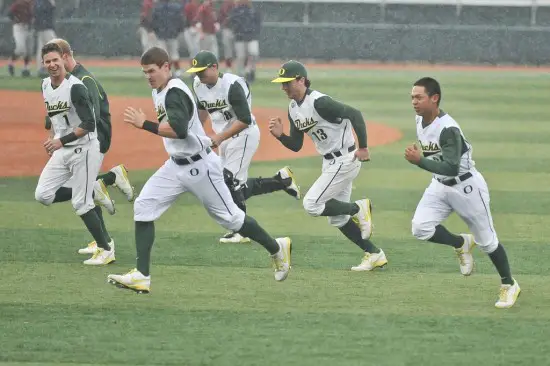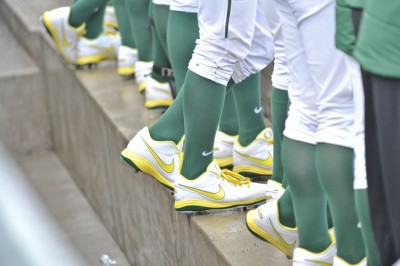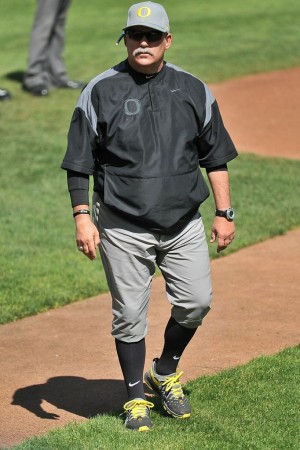My roommate worked at the Cape Cod Baseball League last summer, and he doesn’t hesitate to brag about the dozens of college baseball players he met there. Some of those players go to other PAC-12 schools, so he got a lot of grief when he told them he goes to Oregon. One of the players didn’t make fun of him, though. He just asked a question:
“How the hell did Oregon become good at baseball?!”
Like many people, my roommate didn’t really have an answer. After all, the Oregon baseball program didn’t even exist five years ago. In fact, before being reinstated in 2009, the most recent Ducks’ baseball season was in 1981!
The Ducks, as many expected, struggled in their 2009 campaign, finishing dead last in PAC-10 standings. But now, just four years later, they are one of the best teams in their conference and are a top-15 team in America.
So, how did Oregon baseball make such a fast Drake-ian leap after a 27-year layoff? There are several answers, but three, in particular, have made the largest impacts.
1. Money
As obvious as this answer seems, it must be pointed out that all of the baseball program’s recent success stems from the fact that Oregon has the money to support it. Facilities, coaches, recruiting, scholarships, and every other component of an athletic program require boatloads of money just to field a team. The Oregon athletic department from 1981 can tell you all about this. They were forced to eliminate baseball – along with men’s gymnastics and women’s golf and soccer – purely for financial reasons.
But Oregon didn’t simply want to field a baseball team in 2009, they wanted a good one. In order for that to be possible, they couldn’t just be rummaging for coins under the couch. They needed to use the entire piggy bank.
Pat Kilkenny, UO’s athletic director from 2007-2009, told the Oregonian in July 2007 that baseball was the topic brought up most by Ducks fans since he became the AD in March of that year. I’m sure this fan clamor played a role in the athletic department’s decision, but nobody would have even considered bringing baseball back if Phil Knight and other resources didn’t provide the university with enough money to finance the sport.
Speaking of Phil Knight…
2. Nike
Without Nike, Oregon baseball wouldn’t have the state-of-the-art training facilities, ballpark, or gear. Without these state-of-the-art luxuries, who knows how many Oregon baseball players from 2009 through today would have chosen to play at different schools?
The Ducks had the #10 recruiting class in 2008, according to Baseball America, which is utterly astounding for a brand new program. Oregon couldn’t woo recruits with a “culture of winning” or point to former players who were drafted after the Reagan administration, but they could show off amenities that no other school could match.
Pitcher Scott McGough, one of the players from Oregon’s 2008 recruiting class, told oregonlive.com in 2009, “… once I took a visit here, there was no doubt in my mind that this was the right place for me.”
I don’t doubt that McGough thought Eugene was beautiful when he visited, but who could blame him if PK Park, the luxurious weight rooms, and those flashy Nike uniforms were prominently featured in his mental image of the city?
3. Coach George Horton
After landing a fantastic crop of players in 2009, the Ducks only got better. Baseball America ranked Oregon 24th in their 2010 recruiting rankings, 5th in 2011, and 9th in 2012. Some may give all of the credit to Nike, but that would be insulting to coach Horton and his staff.
Horton was one of the game’s most respected coaches during his years with Cal State Fullerton because he was, well, a fantastic coach.
He turned that program into a college powerhouse because of his brilliant recruiting skills, in-game tactics, and relationships with players.
The best part about that last sentence is that it applies equally to Horton’s tenure with the Ducks. I wish I knew exactly how good he is as a recruiter, but there’s no gray area when it comes to his handling of players and game situations.
Just look at what he’s done this year: he replaced a scuffling Ryan Hambright with the white-hot Mitchell Tolman, he’s kept Jimmie Sherfy fresh by limiting his number of innings, he’s used Jeff Gold as a super effective starter-reliever hybrid, he’s made gutsy call after gutsy call … I could write a whole article praising Horton. For a start-up baseball program, they couldn’t have hired a better coach.
All other contributors to Oregon’s recent success exist because of those three things. Without the abundance of donor support – much of which comes from Nike – it’s doubtful that George Horton would be the coach, and there wouldn’t be as many scholarships to give out. Both of those are vital in bringing talented players to Oregon, as are the Nike-fueled facilities all over Eugene.
People shouldn’t even think about discounting the baseball program’s accomplishments just because it has these resources. It doesn’t matter how much money or Horton you have; a leap that large, that fast is nearly impossible to pull off. They’ve landed top recruits, seen many of them get drafted by MLB teams, and have put a winning product on the field the last three years.
I decided to come to Oregon in spring 2009, during the middle of Oregon’s first baseball season since 1981. It boggles my mind that I am writing about how well the baseball team is playing just four years later. I can’t even pretend to imagine how Ducks fans from 1982-2009 must feel.
Related Articles:
Chip Kelly Update: Everything's Good Again ...
Chip Kelly Update: Wailing and Gnashing of Teeth
Shock and Awe -- The Oregon Ducks' Football Hangover Effect
Despite Lopsided Score, Georgia State "Never Stopped Believing"
Hope Springs Eternal for Ducks
Incompetent Pac-12 Officials: How Do You Miss ALL of THIS?
Victor is a senior at the University of Oregon, majoring in journalism and minoring in psychology. Victor was born and raised in San Francisco, CA. He is a fan of the San Francisco Giants, San Francisco 49ers, and Golden State Warriors and has naturally fallen in love with the Ducks since he became a UO student. He currently works for the UO campus radio station 88.1 KWVA as a news and sports contributor and hopes to one day become a professional sports reporter. While he loves several sports, baseball has always been his greatest passion.



